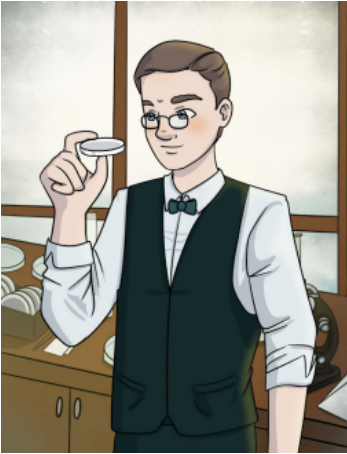The Accidental Discovery That Changed Medicine
By Katherine E.A. Korkidis
Exploring Book 3: Alexander Fleming’s Penicillin Promise
Sometimes the greatest discoveries do not arrive with fireworks or fanfare. They arrive quietly, almost by accident. That is exactly what happened in 1928, when Alexander Fleming returned from holiday to his cluttered laboratory in London and noticed something unusual on a Petri dish he had nearly thrown away. A streak of mold had grown, and around it, the deadly bacteria he had been studying refused to spread.
Most scientists might have dismissed the dish as ruined. Fleming did not. He paid attention. He asked questions. And from that ordinary accident, penicillin was born—the world’s first true antibiotic.
In Alexander Fleming’s Penicillin Promise, the third adventure in the Dr. K’s Portal Through Time series, Jennifer and Daniel step into that very moment in history. Guided by Dr. K, they travel to 1920s London, where horse-drawn carriages share the streets with early motorcars and the skyline is dotted with landmarks like Tower Bridge and St. Paul’s Cathedral. Before meeting Fleming, the children explore the scientific and cultural heart of the city, learning how discovery and invention are woven into every corner of history.
When they finally meet Fleming in his laboratory at St. Mary’s Hospital, the children are struck by the clutter, the Petri dishes stacked high, and the quiet determination of the man at the center of it all. He is not a superhero in a cape, but a scientist with sharp eyes and a curious mind. As Jennifer and Daniel watch him study his “mold juice,” they realize that sometimes the simplest observations, ones others might miss, can lead to discoveries that save millions of lives.
The book also shows that Fleming’s work was just the beginning. Science does not stop with one person or one moment. The path from a moldy Petri dish to a medicine that could be mass produced took years of collaboration among chemists, engineers, and doctors. During World War II, penicillin became a lifeline for soldiers who might otherwise have died from infections. The story highlights teamwork, perseverance, and the role of science in responding to real human need.
For young readers, Fleming’s story is a reminder that discovery often begins in the most ordinary places. A streak of mold, a sharp eye, and a curious question became the seeds of a medical revolution. It encourages children to see themselves as explorers of their own world, never afraid to notice the small details or ask “why.”
Alexander Fleming’s Penicillin Promise continues the spirit of Galileo’s Points of Light in the Night Sky and Marie Curie’s Radiant Quest. Each book invites children to view history not as
something distant, but as a living story, one filled with curiosity, courage, and imagination. By stepping through Dr. K’s magical portal, readers not only witness scientific breakthroughs but also learn that science is shaped by people just like them, people who dared to look more closely and think differently.
This adventure through time is more than a story about medicine. It is about the power of curiosity, the courage to keep asking questions, and the importance of seeing possibilities where others see only accidents. It is about heroes who wear lab coats instead of capes, and how their quiet work can ripple across generations.
Alexander Fleming’s Penicillin Promise invites children and families alike to celebrate science as a journey, full of twists, setbacks, and surprises, but always moving toward hope.

